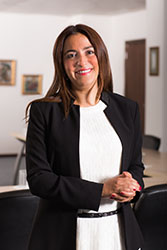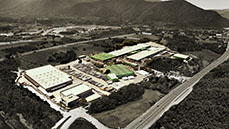

Keeping the tradition of innovation alive
With a sale unit increase of 27% in the first 8 months of 2014, Kässbohrer stands out as the fastest growing European semi-trailer manufacturer of the year. We recently spoke with Ms. Iffet Türken, the Business Development Executive Board Member at the company, about the selection of Germany as a manufacturing location, the approach to innovation, and how products are adapted to different markets. Check out this interview to learn about the interplay between the traditional manufacturing company and its Turkish parent company, Tirsan, and the waves they're making in the semi-trailer industry.

GSC: Having become an industry leader in Turkey shortly after the firm's establishment, one of the first foreign investments by TIRSAN was in 1998, with the opening of the first Turkish-owned trailer manufacturing plant in Europe, located in Goch, Germany. While famous for its own "hidden champions", Germany is not typically considered a traditional location for foreign manufacturing investments. What appealed to TIRSAN about Germany as a manufacturing location?
İffet Türken: Within the scope of our company strategy and given the concentration of the core competition in the semi-trailer market, investing in Western Europe seemed like the natural step forward. However, before opening our current facility in Goch in 1998, we also evaluated other countries as well, including the Netherlands and Belgium, where foreign investment is better supported. However, we chose to make our investment and establish our European base in Germany, because the country shines as a leader in both innovation and the automotive industry and, as a result, in innovative automotive engineering as well. We thought that in order to compete with top trailer manufacturers in Europe, that's where we ought to be. Challenges tempted us. Once we decided to invest in Germany, we had three location options: Goch, Kalkar and Emmerich. I must say that we received great informational support from both the local authorities and investment agencies. As Goch is located in between E-31 and E-35, part of the European route of the international E-road network developed by the United Nations that runs from Amsterdam to Rome, the Goch plant has a strategic position at the heart of German export and intermodal logistics. Since our acquisition of Kässbohrer's tank and silo business in 2002, the Goch facility has become the headquarters of Kässbohrer Fahrzeugwerke GmbH and is also its distribution center for Europe. The facility can therefore also be seen as an export hub.
GSC: Established in 1893, Kässbohrer has a long tradition of innovation used to create high-quality automobiles that push the boundaries of automotive engineering. In what ways has the approach to innovation changed since the acquisition of the firm by the significantly younger Turkish company, TIRSAN?
İffet Türken: Simply put, Kässbohrer and Tırsan are a perfect match. On top of Kässbohrer's legacy of innovation and engineering, Tirsan brings ingenuity and flexibility to bear on customer service. Along with Tırsan's production capabilities and its eagerness to invest, not only in production but also in R&D and management systems, Kässbohrer is now better positioned to continue to innovate to meet its global customer demands. We believe in partnerships in every step of the business, and R&D activities are not exception. We are conducting engineering work in cooperation with several universities. Moreover, we are running tests and analyses in cooperation with companies and institutions including MAN, Ford Otosan, DEKRA, MIRA Engineering, Wabco Vehicle Control Systems and OTAM. In 2009, we restructured our R&D organization and founded a new R&D center in our Adapazari plant. In 2014, we developed three new trailer technologies and participated in Trailer Innovations 2015. In partnership with Knorr Bremse, we developed the Steer By Brake (SBB) System to reduce the operational complexity in steering for efficiency and safety by eliminating the need for self-steering axles in low-bed and low-loader vehicles with a revolutionary approach. We also developed the Rear Underrun Protection Device with Absorption Box (RUPD-AB) to maximize the safety of the driver and passengers in tailing vehicles. The new RUPD-AB absorbs the force that is emitted during an accident and directly transfers to the driver and passengers in the rear of the vehicle in traditional equipment. Finally, we engineered the Digital Trailer Control (DTC) unit to maximize the safety of drivers and operators. Whereas drivers and operators have to use different equipment on a trailer such as parking brakes, landing gear, the folding bumper and the roof lifting for a tautliner, DTC enables centralized systematic control of these functions from a safe distance and clear sight. Getting back to your question on how the approach to innovation has changed since the acquisition of Kässbohrer by Tirsan, I can say that now we are even more ambitious when it comes to innovation and we have more sources to develop.
 GSC: Kässbohrer products are used in over 50 countries, and the company itself has production facilities in 3 different countries: Germany, Turkey, and Russia. How must you adapt your products on a country-by-country basis to satisfy your customers?
GSC: Kässbohrer products are used in over 50 countries, and the company itself has production facilities in 3 different countries: Germany, Turkey, and Russia. How must you adapt your products on a country-by-country basis to satisfy your customers?
İffet Türken: One of the most important strengths we have is our product range, which is the widest range any semi-trailer manufacturer has to offer. In order to offer such a wide product range, we have structured our organization in such a way that each product type is designed, tested, produced, controlled and marketed by a separate specialized team. For example, our Adapazari plant is comprised of eight different factories, each dedicated to a single product group. Having a separate specialized team and organization for each product segment gives us the opportunity to perform effective field research, where we can clearly determine the country specific needs. Besides that, every single product is engineered with our business partners, in response to very specific and detailed needs. This approach provides us with a clear picture of a country in terms of product needs. That's how we engineered our tipper exclusive for the Russian market, for example, which is not only in line with the country's regulations and common usage, but also tough enough to overcome Russia's challenging weather and road conditions.
GSC: With a sale unit increase of 27% in the first 8 months of 2014, Kässbohrer stands out as the fastest growing European semi-trailer manufacturer of the year. Which new activities has the company undertaken in order to inspire such rapid growth?
İffet Türken: First of all, we have expanded our sales network. In 2014, our international sales operations headcount increased by 150% in Europe, by 133% in Russia and by 50% in Turkey. On top of that, we have introduced new products and technologies and increased our production capacity. Back in February 2014, we introduced the hydraulic steering system in our low-beds and started to produce low-loaders. We also introduced the new tipper, exclusively for the Russian market. We had quite impressive results in 2014, despite all of the uncertainties affecting the economic and political atmosphere. Once again, we are the clear market leader in Turkey. We doubled our sales in Germany and increased our sales in the Netherlands by 79.5%. We are expecting good results from other markets as well, as soon as the 2014 data sets are completed.
GSC: The 5-year plan for development at Kässbohrer was announced in 2013. How were the areas requiring further development determined, and what can we expect to see from the company in 2015?
İffet Türken: In 2014, we expanded our tank and silo production facility by 40%. Accordingly, our aluminum tank and silo production capacity grew by 48% and the stainless tank production capacity increased by 42% in 2014, both year-on-year. We plan to further capacity expansion in 2015, thus increasing our total tank and silo production capacity by twofold compared to 2013. Additionally, we expanded our low-bed factory by three times. Consequently, our low-bed production capacity rose by 75% year-on-year in 2014. With further investment, we will increase our low-bed production capacity by 125% in 2015 compared to 2013. In 2014, we commissioned our cataphoresis plant in full automation and as a result we are expecting to see better production results and increased effectiveness. In the meantime, we will introduce new products in different product groups in 2015, although I cannot provide you any further detail for now.
GSC: Thank you for this interview, Ms. Türken.
More information: http://de.kaessbohrer.com/
